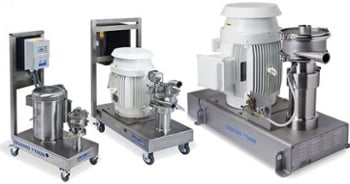Emulsification
The emulsification process is used to produce a wide array of lucrative consumer products. Generally, an emulsion is a viscous, uniform substance created from two otherwise immiscible liquids — typically an oil and water mixture — and a third component, which facilitates mixing. This component is known as an emulsifying agent or an emulgent.
Of course, the final “ingredient” is energy, usually supplied in the form of shaking, blending, agitation, or some other vigorous motion. The best high shear industrial mixers are capable of achieving emulsification quickly and efficiently.
Emulsions can be found in numerous industries, making commodities anywhere from milk, yogurt, mayonnaise, and salad dressings, to shampoos, body wash and sun lotions, and so on. Homogenized milk, for example, consists of lipids (oil) dispersed more or less uniformly throughout a water-based matrix (skim milk). Milk proteins serve as emulsifying agents in this instance, helping to stabilize the mixture once these two incompatible substances have been thoroughly blended.
Oil-in-Water vs. Water-in-Oil
Emulsions may be either oil-in-water or water-in-oil. Technically, when generating oil-in-water vs. water-in-oil emulsions, one phase (known as the dispersed phase) is mixed into the other (the continuous phase). In other words, one liquid serves as a sort of base into which another liquid is added. When an emulsion is “oil-in-water,” oil is the dispersed phase that is distributed into the continuous phase, water. In a water-in-oil emulsion, the roles are switched. Milk is an example of an oil-in-water emulsion, while butter is water-in-oil.
What’s the Difference Between Oil-in-Water and Water-in-Oil?
Customers sometimes wonder about the distinction between an oil-in-water emulsion vs. a water-in-oil emulsion. A chief difference involves the use of emulsifying agents since some are more compatible with one phase than the other. An emulgent that is easily soluble in water is likely to facilitate an oil-in-water emulsion better than water-in-oil. Otherwise, the primary difference between an oil-in-water and water-in-oil emulsion is which type of liquid is suspended throughout the other.
Stable Emulsions Are Key
Numerous industries rely on the ability to create stable emulsions efficiently. Note the use of the modifier, “stable”. While it’s possible to make a temporary emulsion by energetically mixing liquids together, such as with an oil-and-vinegar salad dressing, the phases will quickly separate if droplet sizes are not sufficiently small. Home cooks usually stabilize vinaigrettes by adding a dollop of mustard, which contains natural emulgents, and beating vigorously.
Emulsified products manufactured for consumers are typically achieved using industrial blenders. These machines vary widely in design and the time and energy they require to create stable mixtures. Given that time is money in any business, a high speed and efficient combination are obviously desirable.
Submicron homogenizing and high shear wet milling
No matter what type of emulsion you are interested in creating, Quadro Liquids has the perfect machine for the job. Our HV Emulsifier & Wet Mill, for instance, excels at rapid, high shear emulsification tasks.
Do you need help with your liquid processing challenges
In nearly 20 years of delivering the most efficient mixing and processing solutions to our customers worldwide, our experts have never allowed conventional thinking to get in the way.
Not sure which mixer is for you? Try our product selector tool - just select your application and industry and our equipment selector will provide you with the range of equipment suitable for your processing needs.
We continually develop innovative solutions that exceed expectations and break traditional assumptions about processing limitations.
If you have a particular issue that you are investigating then please don't hesitate to contact us.
Related Articles
Topics:
Emulsification


